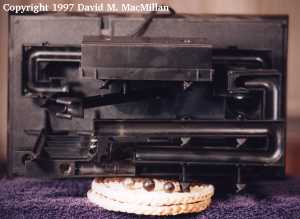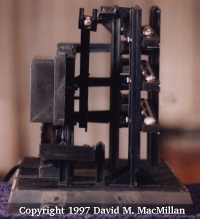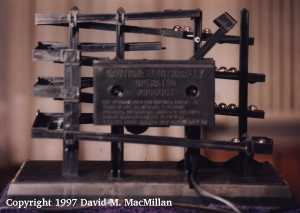
Mayenschein RB Display Clock, Patent Fig. 1
This image was scanned by the author from a copy of US Patent 4,077,198 purchased from the USPTO.
US patent texts and images are in the public domain.
The Rolling Ball Web
An Online Compendium of
Rolling Ball Sculptures, Clocks, Etc.
By David M. MacMillan et. al.
(6 images, approximately 60.2 kilobytes total)
In 1978, Harley Mayenschein of Schaumburg, IL was granted US Patent 4,077,198, "Clock Apparatus," for a rolling ball display clock of the "1-5-60" tilting arm type (patent filed Dec 27, 1976). The full text and images of this patent are online at the IBM Patent Server. Copies of patents may be ordered directly from the US Patent and Trademark Office
In the wonderfully obscure language of patents, he described his invention thus:
ABSTRACT: A novel clock apparatus is provided which visually indicates attained time of day by the design of the placement order of free movable spheroids on a pivotable spheroid holder member effective to be sustained in a first stable position whereby spheroids can be loaded thereon to be positioned with reference to time related indicia numerals thereon until the number of such spheroids are then effective to cause pivoting of said holder member to a second stable position whereby loaded spheroids can be unloaded therefrom to place such unloaded spheroids into a closed or endless loop motion system whereby collecting means collect the unloading spheroids for reuse and time reference loading means reuse the unloaded spheroids against a predetermined time reference unit such as a minute by reloading the spheroids on to the holder member.
Click on photo for larger image (50.1k)

Mayenschein RB Display Clock, Patent Fig. 1
This image was scanned by the author from a copy of
US Patent 4,077,198 purchased from the USPTO.
US patent texts and images are in the public domain.
A wooden clock of this design was constructed by Mayenschein and donated in 1978 to the Museum of the National Association of Watch and Clock Collectors (NAWCC) - accession no. 78.33.1. The placard for this clock identifies it as the "IDLE-TYME TIMEPIECE."
The NAWCC also has a warranty card, apparently associated with this clock, from the Idle-Tyme Company, P.O. Box 117, Sextonville, WI 53584. A second placard associated with this clock indicates that Mayenschein was at the time resident in Sextonville, that it took him four months to build this wooden clock, and that it was displayed at an unspecified NAWCC convention.
Thanks are due to Cindi Nicotera, former assistant librarian at the NAWCC Library, for tracking down information about this clock.
Clocks which operate on this principle were distributed in the US in the 1980s under the name "Arrow Manufacturing Company." I know nothing about this company, but as this manufacture occurred during the effective period of Mayenschein's patent, I assume that it was done under license.
Timesavers, a horological supply company, sells parts for these clocks.
Timesavers
7745 East Redfield Road, Suite 500
Scottsdale, AZ 85260
USA
(800) 552-1520, (602) 483-3711 voice
(800) 552-1522, (602) 483-6166 FAX
clocks@timesavers.com
http://www.timesavers.com/
The following photographs illustrate the Arrow Mfg. Co. clock in the author's possession. The time shown on the clock is 12:59 and about 50 seconds. 12:59 is the time when a clock of this design has the most balls on display.
For the best view, please resize your web browser's window to accomodate the full width of these images, if possible.
This clock was purchased by my wife for $5 at a garage sale. At that time, it was in pieces (but, somewhat miraculously, all of the pieces were there) and terribly stained by years of cigarette smoke. The seller didn't even realize that it was a clock. However, cleaned up and reassembled it works well enough.
In reassembly, some of the snap-together plastic joints had shrunk or deformed and needed to be shimmed for a secure fit. In operation this clock is very dependent upon being level. Unless it is perfectly level, the returning balls will not always got to the end of the ball reservoir, causing the clock's display to miss a minute. Sometimes a ball will jump a the track, but never when I'm looking.
I have had to replace the motor once (though, curiously, the original motor has started working again). In my case, the flat on the shaft of the replacement motor was not identical to that on the original, causing the main rotating arm to wobble. It was possible to shim this to compensate.
I've also taken a sequence of photographs
illustrating the operation of this clock.
(26 photos, approx. 264k)
Click on any of the images below for a larger version of the image.
Click on photo for larger image (23.5k)
|
||
Click on photo for larger image (23.4k)
|
Click on photo for larger image (21.6k) Photos by and Copyright © 1997 David M. MacMillan |
Click on photo for larger image (23.5k)
|
Click on photo for larger image (30.8k)
|
||
WWW Technical Note: The larger views of the five images above should appear each in a new browser window, if your web browser supports the nonstandard feature I used to enable this behavior (see below). If it does, then you can move or resize this window in a manner independent of the main window. When you are done with this new window, use your browser's "close" menu item in this window to close it (or simply close the windows itself using whatever method your operating system provides for closing windows). Please note that using your browser's "back" button in this new window may produce unpredictable results.
If your web browser does support this behavior, then I hope that this new image (actually a separate web page containing this new image) will simply replace the current page. If so, use your web browser's "back" button to return to the current page.
If something else happens, I'd be interested in knowing about it.
In about 1997 there appeared on the US market a clock similar enough to the Arrow clocks to suggest that it might even have been made from the same injection molds. This clock is marketed under the name "Time Machine."
With the exception of any material noted as being in the public domain, the text, images, and encoding of this document are copyright © 1997-1998 by David M. MacMillan.
This document is licensed for private, noncommercial, nonprofit viewing by individuals on the World Wide Web. Any other use or copying, including but not limited to republication in printed or electronic media, modification or the creation of derivative works, and any use for profit, is prohibited.
This writing is distributed in the hope that it will be useful, but "as-is," without any warranty of any kind, expressed or implied; without even the implied warranty of merchantability or fitness for a particular purpose.
In no event will the author(s) or editor(s) of this document be liable to you or to any other party for damages, including any general, special, incidental or consequential damages arising out of your use of or inability to use this document or the information contained in it, even if you have been advised of the possibility of such damages.
In no event will the author(s) or editor(s) of this document be liable to you or to any other party for any injury, death, disfigurement, or other personal damage arising out of your use of or inability to use this document or the information contained in it, even if you have been advised of the possibility of such injury, death, disfigurement, or other personal damage.
All trademarks or registered trademarks used in this document are the properties of their respective owners and (with the possible exception of any marks owned by the author(s) or editor(s) of this document) are used here for purposes of identification only. A trademark catalog page lists the marks known to be used on these web pages. Please e-mail dmm@lemur.com if you believe that the recognition of a trademark has been overlooked.
Version
1.6, 1998/06/18.
Feedback to dmm@lemur.com
http://www.database.com/~lemur/rbc-arrow.html
Go to the: